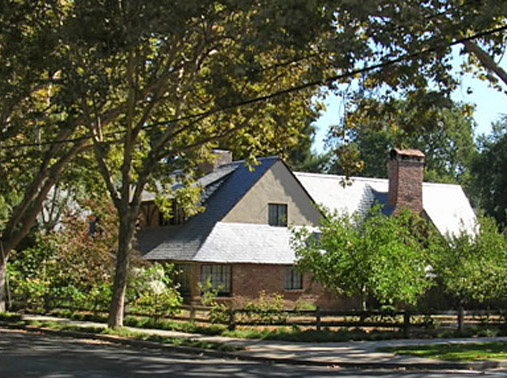 Palo Alto Stanford Heritage
Palo Alto Stanford Heritage  |
The only house in Palo Alto designed by Carr Jones is at 2101 Waverly Street and it’s easy to miss amid its trophy companions. Jones built this two–story residence for his brother, Harry E. Jones and his wife, Leila. Harry, a retired Army officer, sold the house after his wife’s death.
The new owner, Adelaide Hillhouse Ford was the widow of Major George William Ford, a veteran of the Spanish American War. Adelaide had seen and admired the house during her trips from San Francisco to Palo Alto. Perhaps her European sensibilities, developed while studying art in Italy and France, influenced her choice. Although something of a recluse, Adelaide was the author of several books of poetry including the well–received volume, The Fabric of the Loom.
Subsequent owners of the house included a Stanford Professor of Clinical Surgery and a high tech innovator. Carr Jones (1885–1965) was born in Watsonville and raised in Monterey. After his family moved to Berkeley, he attended Cal, receiving a degree in mechanical engineering in 1911. What prompted Carr to become a designer/builder is not clear, but his first houses were built north of the Berkeley campus in 1914 and 1916 and were Craftsman in style. By the 1920’s, Carr developed the style which became his trademark. He built fewer than 50 houses in what is commonly called the Storybook style or, technically, Provincial Realism.
Popularized in the 1920s–1930s, Storybook architecture had its roots in the Hollywood film industry. Characterized by uneven roofs, artificial aging and a diminutive scale, most are whimsical, romantic and reminiscent of Hansel and Gretel. The Storybook houses that Jones produced were, however, unique. His engineering background and the fact that he never traveled abroad nor even outside California freed him from architectural pretension. Based on his core values of domestic comfort, conservation and craftsmanship, he fabricated one–of–a–kind houses, often living and working on site with his crew. In addition to his careful workmanship and his imaginative manipulation of materials, Carr Jones was a pioneer in green architecture. He used salvaged timber, brick and castoff pieces of tile, slate and iron to create lyrically beautiful structures.
The 5,768 square foot house at 2101 Waverly is one of his most representative designs. Describing the slate roof of this two–story house as having multiple intersecting gables does not prepare the viewer for the sculptural dimensions it achieves. Right angles seem not to exist as one gable swoops to meet another or joins a chimney or dormer in undulating waves. Roughly laid and unfinished red brick covers the exterior and interior of the 16” thick walls and is used in a decorative swirling pattern between the three windows of a long shed dormer. Dormers of varying sizes dot the roofline, as do brick chimneys. One of the latter is circular and another broadens dramatically as it descends to the ground floor; both have ornate caps. Steel casement windows dominate in this U shaped house.
A trademark Carr Jones window is found in the pyramid shaped gable end which faces the enclosed courtyard. Filled with glass panes between decorative curved beams, it floods the living room with light. The courtyard nestled between the wings of the house has an arcade and brick patio and is a nod to California Mission style architecture. The interior of this five bedroom house is where Jones’ use of recycled materials is most evident. Used bricks at the walls and irregularly patterned terra cotta tiles on the floor combine with wood scavenged from discarded telephone poles as testimony to his creativity. The kitchen beams had been used to make molds for the concrete foundations of the Golden Gate Bridge which was under construction in 1933. Interior brick walls are enlivened by a variety of arched openings with planked doors. Some tall homeowners find theses arches a challenge, as the builder was a very short man. Most consider them a small sacrifice to pay for living in a house where every space holds an architectural delight.
PAST, June 19, 2015
E-mail us at either webmaster@pastheritage.org or president@pastheritage.org.
![]() Palo Alto Stanford Heritage—Dedicated to the preservation of Palo Alto's historic buildings.
Palo Alto Stanford Heritage—Dedicated to the preservation of Palo Alto's historic buildings.
Copyright © 2015 Palo Alto Stanford Heritage. All rights reserved.